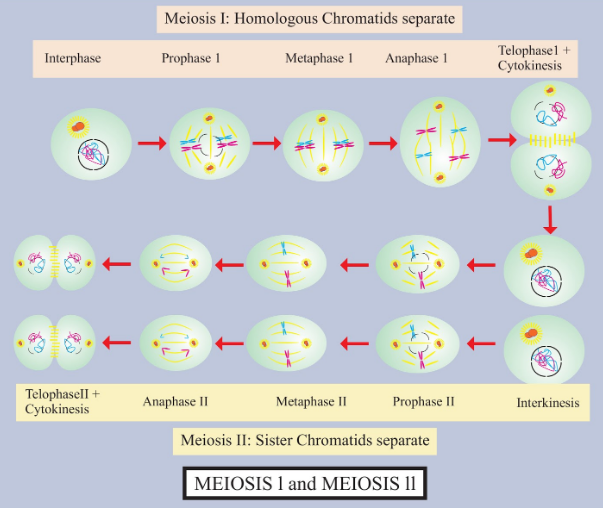
During meiosis, crossing over occurs at
(a) Diplotene
(b) Leptotene
(c) Pachytene
(d) Diakinesis
Answer
517.2k+ views
Hint: Crossing over occurs at the prophase stage of Meiosis I. It occurs at the longest meiotic stage. Several important events of Meiosis take place during this phase. It begins with the completion of synapsis.
Complete answer:
Crossing over takes place at the pachytene stage of prophase I of Meiosis. Crossing over includes the symmetrical division of chromatids, and the reciprocal exchange and crosswise assembly of segments between non-sister chromatids, often breaking linkage. This results in the recombination of genes. Crossing over generally takes place at the pachytene stage of prophase I of Meiosis I. During the pachytene, stage one chromatid of each homolog overlaps or crosses over a corresponding non-sister chromatid of the other homolog at one or more points. These crossing points are called chiasma. At this point, the non-sister chromatids divide transversely with the help of endonuclease. The broken segments are then mutually interchangeable through them. Each interchanged segment mixes with a corresponding segment of non-sister chromatids with the use of ligases. The complete process which requires the breakage, mutual interchange, and reciprocal reunion of chromosome segments are known as crossing over.
Additional Information:
-Mitotic crossing over involves five major events; synapsis of homologous chromosomes and tetrad formation, crossing over of non-sister chromatids and chiasma formation, symmetrical breakage of non-sister chromatids, reciprocal recombination through the mutual interchange and crosswise assembly of broken segments, dissociation of the homologues through the decriminalization of chiasma.
-Synapsis is known as the close pairing of homologous chromosomes throughout the zygotene stage of the first meiotic division.
-Double-crossing over is the process of crossing over which includes two chiasma and two, three, or four chromatids.
So, the correct answer is 'Pachytene'.
Note:
-Crossing over and the independent assortment of alleles are the primary mechanisms for generating new, non-parental gene combinations and genetic variations.
-Natural selection works upon these recombinant genotypes and genetic variations and therefore improves the fitness, survival value, and evolutionary potentiality of the organisms.
-In eukaryotes, the crossing over could be mitotic or meiotic. Mitotic crossing over takes place in somatic cells and finial cells.

Complete answer:
Crossing over takes place at the pachytene stage of prophase I of Meiosis. Crossing over includes the symmetrical division of chromatids, and the reciprocal exchange and crosswise assembly of segments between non-sister chromatids, often breaking linkage. This results in the recombination of genes. Crossing over generally takes place at the pachytene stage of prophase I of Meiosis I. During the pachytene, stage one chromatid of each homolog overlaps or crosses over a corresponding non-sister chromatid of the other homolog at one or more points. These crossing points are called chiasma. At this point, the non-sister chromatids divide transversely with the help of endonuclease. The broken segments are then mutually interchangeable through them. Each interchanged segment mixes with a corresponding segment of non-sister chromatids with the use of ligases. The complete process which requires the breakage, mutual interchange, and reciprocal reunion of chromosome segments are known as crossing over.
Additional Information:
-Mitotic crossing over involves five major events; synapsis of homologous chromosomes and tetrad formation, crossing over of non-sister chromatids and chiasma formation, symmetrical breakage of non-sister chromatids, reciprocal recombination through the mutual interchange and crosswise assembly of broken segments, dissociation of the homologues through the decriminalization of chiasma.
-Synapsis is known as the close pairing of homologous chromosomes throughout the zygotene stage of the first meiotic division.
-Double-crossing over is the process of crossing over which includes two chiasma and two, three, or four chromatids.
So, the correct answer is 'Pachytene'.
Note:
-Crossing over and the independent assortment of alleles are the primary mechanisms for generating new, non-parental gene combinations and genetic variations.
-Natural selection works upon these recombinant genotypes and genetic variations and therefore improves the fitness, survival value, and evolutionary potentiality of the organisms.
-In eukaryotes, the crossing over could be mitotic or meiotic. Mitotic crossing over takes place in somatic cells and finial cells.

Recently Updated Pages
Master Class 12 Business Studies: Engaging Questions & Answers for Success

Master Class 12 Economics: Engaging Questions & Answers for Success

Master Class 12 English: Engaging Questions & Answers for Success

Master Class 12 Maths: Engaging Questions & Answers for Success

Master Class 12 Social Science: Engaging Questions & Answers for Success

Master Class 12 Chemistry: Engaging Questions & Answers for Success

Trending doubts
What is meant by exothermic and endothermic reactions class 11 chemistry CBSE

Which animal has three hearts class 11 biology CBSE

10 examples of friction in our daily life

One Metric ton is equal to kg A 10000 B 1000 C 100 class 11 physics CBSE

1 Quintal is equal to a 110 kg b 10 kg c 100kg d 1000 class 11 physics CBSE

Difference Between Prokaryotic Cells and Eukaryotic Cells




